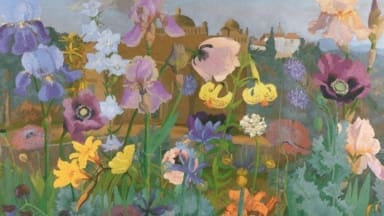
The exhibition, which runs from the 6th of July until the 3rd of November, charts the extraordinary and intertwined careers of Cedric Morris (1889–1982) and Arthur Lett-Haines (1894–1978) from the 1920s and 30s, when they were central to the bohemian and avant-garde scenes of Newlyn, London and Paris, to the 1940s and beyond, when the pair were based in Suffolk.
Morris is known for his love and intense observation of nature, demonstrated in the exhibition by his beautiful paintings of flowers, birds, people and places. Lett’s works in the realms of surrealism and abstract and organic forms are less well-known, but ripe for admiration.
The artist-plantsman, Morris grew up in Sketty, South Wales. He spent his younger years intermittently abroad, travelling across Europe and North Africa, whilst renting studios in Cornwall, Paris and London. In the 1930s, Cedric and his partner, the artist Arthur Lett-Haines (‘Lett’), made South Suffolk their permanent base, moving to Pound Farm in Higham and founded the bohemian East Anglian School of Painting and Drawing (1937–78). In Suffolk, Morris and Lett, cultivated a haven for like-minded creatives and teaching young artists, famously including Lucian Freud and Maggi Hambling.
The school started life in Dedham, but following a devastating fire in 1939, moved to the large farmhouse of Benton End in Hadleigh, where Cedric and Lett also lived. More of an artistic community than a school, the East Anglian School of Painting and Drawing encouraged individuality and painting en plein air.
Principally a painter, but Morris was also an avid plantsman and noted iris breeder. He travelled extensively, to places such as Portugal and Turkey to paint and find plant species that he would then establish in the garden at Benton End. He bred tall bearded irises, naming 90 cultivars, (most of) which carry the ‘Benton’ prefix. He was a vice chairman of the British Iris Society, won the Foster Plaque for Iris breeding in 1949 and gained the highest accolade, the Dykes Medal for his Iris ‘Benton Cordelia’. The garden at Benton End was influential for its naturalistic style and its collection of rare and unusual plants, which Morris brought back from his regular winter sojourns aboard.
Benton End is a Grade II* listed 16th century, half-timbered house and enjoys a commanding position overlooking the Brett Valley. In trust, the Benton End House and Garden exists through the generosity and vision of The Pinchbeck Charitable Trust, who gifted Benton End to the Garden Museum in 2021.
Gainsborough’s House
Spread over two floors of the new galleries, the Morris & Lett exhibition will bring together a large selection of paintings, drawings and sculptures from public and private collections. The Gainsborough’s House Museum first opened to the public in 1961 and is the largest gallery in Suffolk. Thomas Gainsborough (1727–88) was born in Sudbury, the fifth son and ninth child of John and Mary Gainsborough. In 1958, Gainsborough’s House Society was formed which establish it as a centre for Thomas Gainsborough. The Museum has a beautiful historic garden, which is maintained by devoted volunteers.
Gainsborough’s House holds the largest collection of artwork by Cedric Morris. In 2017 a significant collection of 52 paintings and 62 drawings by Morris was given to Gainsborough’s House by Maggi Hambling and Robert Davey. The collection includes early portraits and still lifes from his time in Newlyn, Cornwall, shortly after World War I; portraits, life drawings and bohemian café scenes from the 1920s when he lived in Paris; rare experiments with surrealism and abstraction; portraits of friends and students from when he was based in Suffolk; delicate plant studies in silverpoint; and numerous exotic landscapes in hot colours that document his annual winter travels to places such as Algiers, Mexico and the Portugese Azores.
For further information about the Morris & Lett-Haines exhibition, we refer you to the Gainsborough House.

